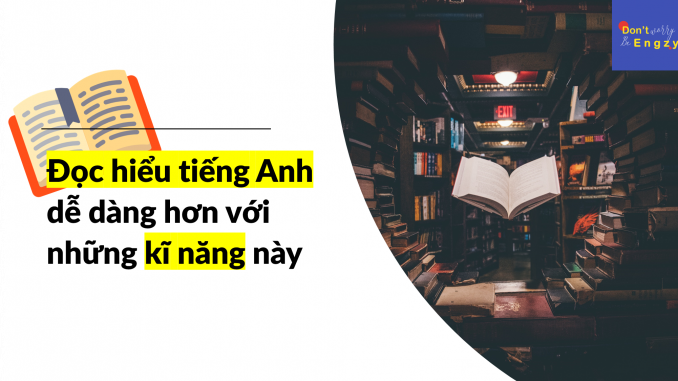
Trong các đề thi, đặc biệt kì thi THPT Quốc gia đều có từ 2 đến 3 bài đọc: bài đọc trả lời câu hỏi, tìm câu trả lời có trong nội dung bài đọc hoặc bài đọc điền từ thích hợp vào chỗ trống. Vậy làm thế nào để làm được tốt bài đọc chỉ trong một khoảng thời gian ấn định đây? Các bạn hãy đọc kĩ những chia sẻ dưới đây nhé:
Vì chúng ta làm một bài thi hoặc bài kiểm tra có phần đọc hiểu nên phải tập trung vào các câu hỏi bên dưới nội dung các bài đọc trước để tìm key word chính nhất trong câu hỏi đó rồi lướt nhanh (scan) tìm trên nội dung bài đọc vị trí liên quan tới key word đó và quyết định đáp án phù hợp.
Bí quyết giúp bạn cải thiện kỹ năng đọc hiểu tiếng Anh.
Không đọc chi tiết trình tự từ đầu đến cuối bài đọc đâu nhé.
Hệ thống câu hỏi trong phần đọc hiểu thường có các dạng như sau:
1. Tìm thông tin chi tiết (Reading for details)

“According to the passage, what happened …….” ở dạng câu hỏi này yêu cầu bạn tìm thông tin chi tiết nhưng bạn nhớ không được đọc cả bài một cách chi tiết mà phải chú ý đến các từ chìa khóa (key words) được dùng trong câu hỏi. Thông tin trả lời có thể không phải là những từ hay cụm từ bạn thấy trong bài mà là các cụm từ đồng nghĩa hoặc diễn đạt khác về thông tin cần tìm. Thông thường thì thông tin trả lời cho các câu hỏi này được sắp xếp theo trình tự của bài đọc.
For example:
The ancestors of humans had a lot more hair than the humans of today; in fact, they had thick hair all over their bodies. This thick hair was necessary for protection against the cold of the Ice Ages.
As Earth got warmer, the hair began to thin out, except for on the head. The head hair has remained through the evolutionary process, both as a sort of pillow to cushion the sensitive head when it gets banged around and as a sort of hat to keep the head warm and prevent so much heat from escaping through the scalp.
The question: According to the passage, what happened as the temperature on earth increased?
A. The hair on the head began to thin out.
B. The hair on body remained the same.
C. The hair on the body got thicker.
D. The hair on the body began to thin out.
2. Tìm thông tin tham chiếu và nghĩa của từ (Reading for reference and vocabulary)
- Với câu tham chiếu: “The word …in line …is closest in meaning to …….” Để tránh lặp lại từ, bài đọc thường dùng các từ it, them, they, this, …. để trả lời bạn nên chú ý lựa chọn đáp án nào phù hợp nhất sẽ là câu trả lời.
- Với câu hỏi về từ vựng: + Nếu bạn không tìm ra câu trả lời ngay về từ ngữ cảnh, hãy đoán nghĩa thông qua các thông tin xung quanh ngữ cảnh. + Đôi khi nghĩa của từ nằm gần từ nhưng lại được thể hiện bằng từ đồng nghĩa hoặc diễn giải nghĩa. + Có khi mối thông tin không nêu rõ ra mà chỉ được ngầm hiểu, lúc này bạn cần đọc lướt toàn bộ bài đọc. Cần lưu ý có các lựa chọn đưa ra trong dạng câu hỏi này đúng nghĩa từ đã cho nhưng không hợp nghĩa từ của bài đọc nên bạn phải tìm nghĩa hợp chủ đề bài đọc này.
For example:
When babies are born, they always have blue eyes. This is because the melanin, the pigment that colors the eyes, is not on the surface of the iris. Instead, it is within the creases of the iris. Because there is little melanin on the surface of the iris, the eyes appear blue. After a few months, the melanin moves to the surface of the iris. It is the amount of melanin on the surface that determines a person’s permanent eye color, so it is at this point that a baby’s eyes develop the color they will have for a lifetime.
The question: The word surface in line 2 is closest in meaning to ……
A. inside
B. top
C. bottom
D. back
3. Tìm các ý chính trong bài (Reading for main ideas)

+ Ý chính là ý quan trọng nhất trong bài đọc. Khi ý chính trong một bài đọc không được thể hiện rõ, thường sẽ có câu hỏi yêu cầu tìm chủ đề của bài đọc. Tìm ý chính nhanh nhất là ta nên nhìn một câu, một từ đầu tiên của bài đọc hoặc đoạn văn rồi so với các lựa chọn trong câu hỏi để đưa ra câu trả lời chính xác nhất. Nhớ loại bỏ những đáp án chắc chắn sai.
+ Dưới đây là các ví dụ về câu hỏi tìm ý chính trong bài đọc:
-
What is the main idea of the passage?
-
What is the main idea expressed in the passage?
-
What does the passage mainly discuss?
-
With what topic is the passage mainly concerned?
-
The primary idea of the passage is …?
-
The main topic of the passage is …?
-
Which of the following would be the best title?
+ Các lựa chọn sai về ý chính có thể là một trong các trường hợp sau:
- Một câu mà ý nghĩa của nó chỉ đúng với một chi tiết hoặc một đoạn văn trong bài đọc.
- Các câu có phạm vi quá rộng, ra ngoài phạm vi bài đọc.
- Các câu có nội dung không đúng hoặc thể hiện cách hiểu sai về ý chính của bài đọc.
For example:
Basketball was invented in 1891 by a physical education instructor in Springfield, Massachusetts, by the name of James Naismith. Because of terrible weather in winter, his physical education students were indoors rather than outdoors. They really did not like the idea of boring, repetitive exercises and preferred the excitement and challenge of a game. Naismith figured out a team sport that could be played indoors on a gymnasium floor, that involved a lot of running, that kept all team members involved, and that did not allow the tackling and physical contact of American style football.
The question: What is the topic of this passage?
A. The life of James Naismith
B. The history of sports
C. Physical education and exercise
D. The origin of basketball
4. Đọc để suy luận (Reading for inferences)
+ Đây thường là dạng câu hỏi khó nhất trong các bài đọc. Thông tin để trả lời câu hỏi này đôi không được nêu trực tiếp trong bài đọc mà bạn phải hiểu và ngẫm ra.
+ Các câu hỏi thường đường bắt đầu như sau:
- Which of the following can be inferred about….?
- Which of the following can be inferred from the passage?
- From the passage, it can be interfered that….
- The passage implied that …..
- The author implied that …..
- The passage suggests that ….
- It is most probable that …..
+ Để trả lời các câu hỏi dang suy luận này, bạn cần phải đưa ra kết luận dựa trên các thông tin có trong bài đọc. Đó có thể là điều mà tác giả bài đọc cho là đúng nhưng lại không nêu ra một cách rõ ràng trong bài đọc.
+ Cẩn thận khi đưa ra lựa chọn vượt ra ngoài suy luận mà bạn có thể suy một cách logic từ bài đọc. Các câu trả lời sai thường là câu phóng đại nội dung trong bài đọc.
For example:
The most common family name in the English-speaking world is Smith, which was taken from the job of working with metals. A silversmith, for example, is someone who works with the metal silver. Historical records indicate that the use of this last name is at least 700 years old. Today, there are more than 3.3 million Smiths living in the United States and perhaps another million Smiths living in other English speaking countries worldwide.
The question: It is implied in the passage that family names ……..
A. were short names.
B. had no specific meaning.
C. could be taken from jobs.
D. were always taken from the area where a family lived.
5. Một số dạng khác
+ Các câu hỏi về ngữ cảnh, tùy thuộc vào chủ để của bài đọc. Câu hỏi có thể về nguồn gốc ấn phẩm của bài đọc, tác giả của bài đọc. độc giả, hoặc môn học mà nội dung của bài đọc phù hợp.
+ Câu hỏi về giọng điệu, tình cảm và thái độ là câu hỏi về cảm xúc, ý kiến và quan điểm của tác giả khi viết bài đọc.
+ Các câu hỏi về mục đích chính là hỏi về lý do của tác giả khi viết bài đọc.
For example:
One thing adults and especially parents, don’t always understand is that friendships are a key part of teenagers’lives. As young people grow up and become more independent, the more they demand to spend time out with friends. One typical problem is when parents decide to move to a new area because of work. This can be a very upsetting experience for teenagers. They are bound to feel lonely and this is likely to make them miserable, too. It may take some time for them to develop new relationships, so parents should be patient. They should also try to be relaxed about how much time teenagers spend with their friends. It’s natural for teenagers to want to be out when they can. If they hear only criticism of their behavior, it is likely to lead to a lot of arguments. Encourage teenagers to develop friendships with people they have something in common with. And remember that honesty is the best policy when it comes to talking to teens on any subjects at all, including their friendships.
The question:
1. What is the main idea of the passage?
A. The importance of friendships for teenagers.
B. The relationship between teenagers and their parents.
C. The time teenagers need for social activities.
D. Why teenagers don’t like criticism of their behaviour.
2. Which of the following is stated in the reading passage?
A. Parents always understand their teenage children.
B. Teenagers need more time to be with their friends as they grow up.
C. Teenagers don’t want to be with their friends as they grow up.
D. Teenagers need less time to be with their friends as they grow up.
3. Which of the following is closest in meaning to the word miserable in the passage?
A. misunderstanding
B. mistaken
C. unhappy and uncomfortable
D. happy and comfortable
4. Which of the following is not mentioned in the passage?
A. Moving to a new area can be an upsetting experience for teenagers.
B. Teenagers need time to develop new relationships.
C. Teenagers usually want to go out if they can.
D. Honesty is not so important when talking to teens.
Chú ý:
+ Với những bạn chưa chắc chắn về phần bài viết hay ngữ pháp chúng ta nên làm bài đọc trước và cũng không nên bỏ bài đọc không làm các bạn nhé.
+ Với những câu hỏi tìm ý chính của bài, câu hỏi suy luận và câu hỏi về cảm xúc, ý kiến, mục và quan điểm của tác giả khi viết bài đọc chúng ta nên làm cuối cùng nhé.
–Sưu tầm, chỉnh sửa và bổ sung thêm_
Bạn có thể xem thêm bài tập đọc hiểu ở đây

Leave a Reply